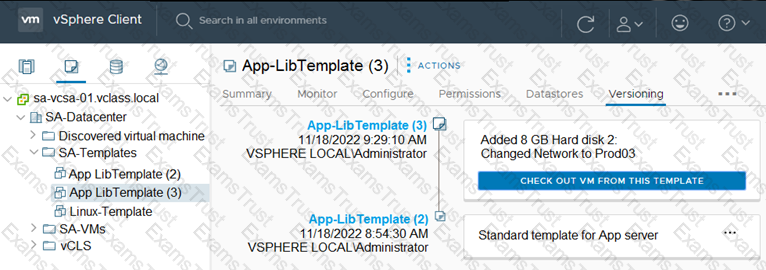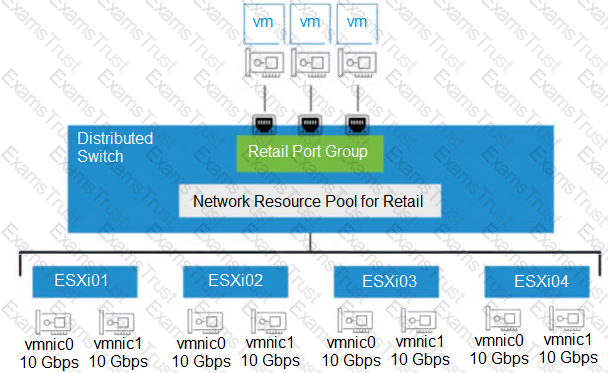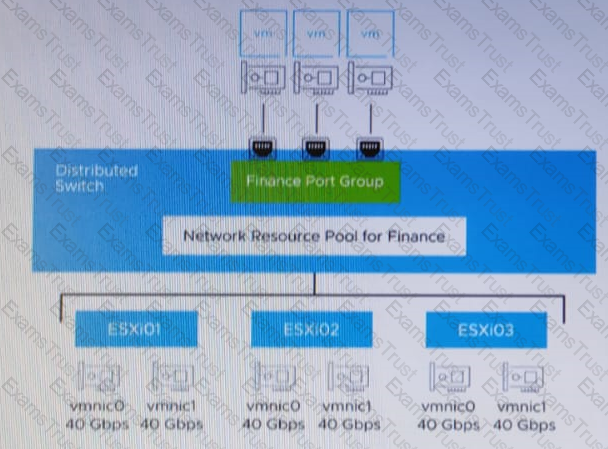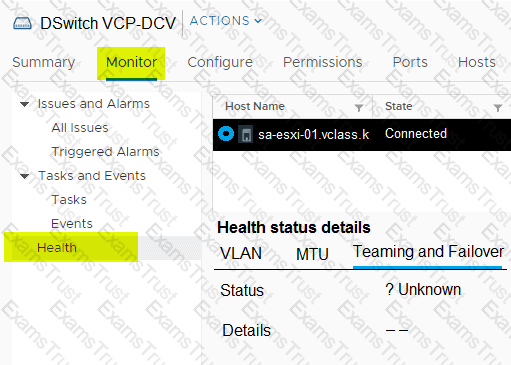An administrator is required to configure several Microsoft Windows virtual machines (VMs) to support Secure Boot for a critical secure application.
The following information is provided:
•The corporate security policy states that all forms of data encryption must utilize a key provider.
•The firmware of each VM is currently set to use Unified Extensible Firmware Interface (UEFI).
•Due to the nature of the application running within the VMs, the guest operating system for each VM is currently a minimum of Windows Server 2008 and Windows 7.
Which security feature should the administrator implement to meet these requirements?
Refer to the exhibit.

Given the configuration shown in the exhibit, what should the administrator do if the latest VM template contains changes that are no longer needed?
A VMkernel port is labelled PROD01 and uses the default TCP/IP stack. Currently, this VMkernel port is configured for supporting live virtual machine (VM) migrations.
Which configuration change should the administrator make to isolate live VM migration traffic from other network traffic?
An administrator needs to provide encryption for workloads within an existing vSphere cluster. The following requirements must be met:
• Workloads should be encrypted at rest.
• Encrypted workloads must automatically be encrypted during transit.
• Encryption should not require any specific hardware.
What should the administrator configure to meet these requirements?
An administrator is tasked with configuring vSphere Trust Authority. The administrator has completed the following steps:
• Set up the workstation
• Enabled the Trust Authority Administrator
• Enabled the Trust Authority State
• Collected information about the ESXi hosts and vCenter to be trusted
Which step does the administrator need to complete next?
A vSphere cluster hosts a three-tier application. The cluster has 50% resources available. If a host in the cluster fails, the database server must be online before the application server, and the application server must be online before the Web server.
Which feature can be used to meet these requirements?
An administrator is tasked with looking into the disaster recovery (DR) options for a software-defined data center (SDDC).
The following requirements must be met:
•All virtual machines (VMs) must be protected to a secondary site.
•The source VMs must remain online until the failover.
•When failing over to the secondary site, application downtime is allowed
•The DR failover must be managed from the vSphere Client.
•Costs must remain as low as possible.
How can the administrator accomplish this task?
An administrator notices a Fibre Channel adapter in an ESXi host has been experiencing inconsistent connectivity states.
Which trigger can be used to quickly identify the issue and alert the administrator so that the issue can be resolved?
administrator successfully installs VMware ESXi onto the first host of a new vSphere duster but makes no additional configuration changes. When attempting to log into the vSphere Host Client using the Fully Qualified Domain Name (FQDN) of the host, the administrator receives the following error message:
‘’server Not Found –we can’t connect to the server at esxit101.corp.local.’’
• Host FQDN: esxi 101. Corp. local
• Management VLAN ID: 10
• DHCP: No
• Management IP Address: 172.16.10.101/24
• Management IP Gateway: 172.16.10.1
• Corporate DNS Servers: 172.16.10.5, 172.16.10.6
• DNS Domain: corp.local
Which three high level tasks should the administrator complete, at a minimum, in order to successfully log into the
the vSphsrs Host Client using the FQDN for the exxi101 and complete the configuration (Choose three.)
Which VMware offering will allow an administrator to manage the lifecycle of multiple vCenter Server instances in a single software as a service (SaaS)-based solution to help drive operational efficiency?
An administrator needs to perform maintenance on a datastore that Is running the vSphere Cluster Services (vCLS) virtual machines (VMs).
Which feature can the administrator use in this scenario to avoid the use of Storage vMotion on the vCLS VMs?
Refer to the exhibit.

An administrator set up the following configuration:
• The distributed switch has four ESXi hosts, and each host has two 10 Gbps NICs.
• In the Network I/O Control configuration, the amount of bandwidth reserved for virtual machine (VM) traffic if 4 Gbps.
The administrator wants to guarantee that VMs in the Retail distributed port group can access 50 percent of the available reserved bandwidth for VM traffic.
Given this scenario, what should the size (in Gbps) of the Retail network resource pool be?
An administrator is attempting to configure Storage I/O Control (SIOC) on five datastores within a vSphere environment. The administrator is being asked to determine why SIOC configuration completed successfully on only four of the datastores.
What are two possible reasons why the configuration was not successful? (Choose two.)
An administrator is working with VMware Support and Is asked to provide log bundles for the ESXI hosts in an environment. Which three options Joes the administrator have? (Choose three.)
Which four elements can a vSphere Lifecycle Manager image contain? (Choose four.)
An administrator plans to update the Supervisor cluster and has noticed some of the Tanzu Kubemetes Grid clusters are running an incompatible version.
Which action must the administrator take before proceeding with the Supervisor cluster update?
An administrator wants to allow a DevOps engineer the ability to delete Tanzu Kubernetes Grid (TKG) cluster objects in a vSphere Namespace.
Which role would provide the minimum required permissions to perform this operation?
An administrator is deploying a new all flash vSAN cluster based on the vSAN Original Storage Architecture (OSA).
What is the minimum supported network throughput in Gb/s for each host?
An administrator must gracefully restart a virtual machine (VM) through the vSphere Client but the option is greyed out. The administrator has full administrative access on VMware vCenter and all the objects available in vCenter, but has no access to log onto the operating system.
Which action should the administrator take to meet the objective?
Refer to the exhibit.

An administrator set up the following configuration:
• The distributed switch has three ESXi hosts, and each host has two 40 Gbps NICs.
• The amount of bandwidth reserved for virtual machine (VM) traffic is 6 Gbps.
The administrator wants to guarantee that VMs in the Finance distributed port group can access 50 percent of the available reserved bandwidth for VM traffic. k
Given this scenario, what should the size (in Gbps) of the Finance network resource pool be?
If a distributed switch uses the "Route based on physical NIC load" load balancing algorithm, what does the mean send or receive utilization of an uplink need to exceed for the flow of traffic to move to the second uplink?
An administrator runs a two-node vSphere cluster, which contains two domain controller virtual machines (VMs). The administrator wants to ensure that VMs run on separate hosts without interfering with normal maintenance operations.
How should the administrator configure Distributed Resource Scheduler (DRS)?
Exhibit switch

An administrator configures a distributed switch and adds the first VMware ESXi server to it.
The administrator also performs the following activities:
•The administrator assigns two uplinks to the distributed switch.
•The administrator enables uplink teaming.
When attempting to perform a health check of the teaming policy, the health status of the Teaming and Failover reports as ' Unknown?, as seen in the exhibit.
What can the administrator changes in the distributed switch for the health status to report correctly?
An administrator is completing the configuration of a new vSphere cluster and has enabled vSphere High Availability (HA) and vSphere Distributed Resource Scheduler (DRS).
After adding the ESXi hosts to the cluster, which networking information will the administrator be prompted to provide when using the Cluster Quickstart workflow?
An administrator needs to consolidate a number of physical servers by migrating the workloads to a software-defined data center solution.
Which VMware solution should the administrator recommend?
An administrator needs to configure a content library solution based on the following information:
•A new corporate virtual machine (VM) template is created every month to include all of the latest patches.
•The new VM template should be downloaded from the primary data center site (London) to two secondary data center sites (Tokyo and New York) as soon as possible.
•There is limited disk space available at one of the secondary data center sites (Tokyo) due to an ongoing data center consolidation project.
Which four steps should the administrator take to configure the content library solution before adding a VM template? (Choose four.)
An administrator has a host profile named Standard-Config. The administrator wants to change the other host profiles to use only the storage configuration settings that are defined in the Standard-Config host profile.
What should the administrator do to make this change?
An administrator plans to bring VMware vCenter offline in order to perform hardware mainte-nance on the host where the vCenter Server Appliance is running.
Which vSphere feature must be configured to ensure that vCenter users experience minimal downtime?
What is the role of vSphere Distributed Services Engine?
Which three features are only available when using vSphere Distributed Switches instead of vSphere Standard Switches? (Choose three.)
An administrator receives reports from the application team of poor performance of a virtual ma-chine (VM). The administrator reviews the virtual machine and discovers that it has 20 snapshots that are over 12 months old.
What could the administrator do to improve the VM’s performance?
An administrator is asked to segregate virtual machine (VM) traffic by VLAN on a vSphere standard switch The following requirements must be met:
•VLAN ID on the switch port group must be 4095.
•VLAN tagging must be done at the VM level.
Which tagging mode is required?